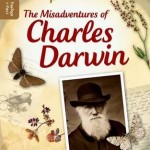news
Science writing for children

My recent guest blog for Oxford Today, featured by Glamour Magazine.
A career as a science writer can feel like a perpetual essay crisis. The regular deadlines. The lengthy excursions through JSTOR. The challenge of chiselling that mountain of knowledge into a perfectly structured narrative. The big difference is that I no longer present the finished piece to an Oxford don. My new audience is much harder to please.

I write for children, who are quick to abandon a book if they are bored. Quite right too — children are born scientists, constantly experimenting to work out what deserves their attention. To make science irresistible to children, you need to think like one. A hundred books into my career, and I’m an expert in thinking like an eight-year-old.
Last year, Oxford University Press asked me to write a book introducing children to evolution through the eyes of Charles Darwin — a dream commission for a Human Scientist.
The result is The Misadventures of Charles Darwin (OUP, 2015), the story of the adventurous and accident-prone scientist behind that famous bushy beard.
My inner eight-year-old discovered that Darwin’s manuscripts and correspondence are full of humorous details, from the perils of storing insect specimens in your mouth, to the fate of that most-famous manuscript On the Origin of Species — used as scrap paper by Darwin’s children to sketch ‘the battle of the fruits and vegetables’.
Humour is a great way to hook young readers, but these misadventures have a second important role. They show children that scientists — even the grumpy-looking ones in textbooks — are people just like them. People who make mistakes. People who aren’t born with all the answers, only questions.
Children relate to this. They instinctively ‘think scientifically’ as they explore the world. Show a group of five-year-olds how frogspawn turns to tadpole turns to frog, and hands shoot up to ask, ‘If frogs lay eggs, where did the first frog come from?’ The challenge of primary science teaching is to harness this curiosity, and let children take the lead. It can be difficult within a curriculum that is too easily reduced to a list of dry facts.
A good children’s science book is nothing like a textbook. It’s an opportunity to tell a complete story that helps children make connections between bite-sized facts and the bigger picture. Make a topic relevant to a child’s life, and you can direct that all-important curiosity exactly where you want it. A relatable story is just the start. Every page, paragraph and sentence must work hard to weave in the science while living up to the promise of your attention-grabbing angle.
The writer must resist the temptation to include everything. First drafts are often double the length of the final text, and the real work comes in deciding what to leave out. Aim to entertain as well as explain, and children will be hooked on science by the time the facts become important for passing exams.
On the first stop of his Beagle voyage, Darwin wrote home bursting with pride at his first discovery: an octopus that he was sure was new to science. His mentor was quick to point out that English beaches were crawling with these cephalopods, but this didn’t diminish Darwin’s excitement in discovering something new to him for the first time.
When I write a science biography, explanation or hands-on activity, I aim to give readers the same feeling. If I can encourage children to pick up the book, think ‘wow’, and keep reading, I’ll know I’ve done a good job.
If they decide to close the book, head outside and start hunting for beetles instead . . . well, then I’ll know I’ve done a really good job.
(Just don’t do as Darwin did, and pop one in your mouth for safe-keeping.)